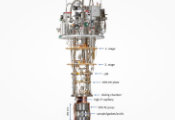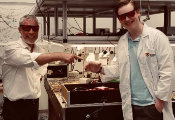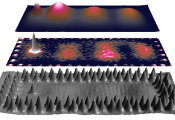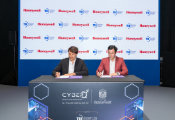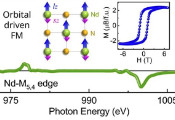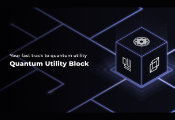Unveiling the Hidden Quantum Structure of Twisted Bilayer Graphene With Terahertz Light
March 27, 2025 -- It has been less than ten years since scientists placed two graphene layers on top of each other, twisted them exactly 1.1º and observed the emergence of exotic phenomena like superconductivity and topological phases of matter. The unlocked new physics attracted great attention among the community, and the whole system soon became known as “magic-angle twisted bilayer graphene”.
This magic-angle has been extensively studied ever since with most efforts focused on understanding how electron interactions lead to such exotic collective quantum phases. However, electrons at the single-particle level have also been predicted to exhibit intriguing quantum behaviours underscored by the geometry of their wavefunctions – their quantum geometry. Yet, observing these behaviours has proven challenging.
Now, a team of ICFO researchers, Dr. Roshan Krishna Kumar, Geng Li, Riccardo Bertini, Dr. Krystian Nowakowski, Dr. Sebastian Castilla, Dr. Hitesh Agarwal, Sergi Batlle Porro, Matteo Ceccanti, Dr. Antoine Reserbat-Plantey, Dr. Giulia Piccinini, Dr. Julien Barrier, Dr. Ekaterina Khestanova, Dr. Petr Stepanov, led by ICREA Prof. Frank Koppens, has brought new insights into the quantum geometry of magic-angle twisted bilayer graphene. By using terahertz light, they revealed anomalous quantum behaviors of electrons when they undergo an energy transition in which they drive a current despite there is not an electric-field being applied.
This way, the researchers unveiled electron phenomena that often remain hidden in quantum transport experiments — the primary method for characterizing quantum materials. Furthermore, the same method provided new insights into the fundamental quantum nature of the high temperature interacting phases that might arise within graphene. The study, published in Nature Materials, has been carried out in collaboration with The University of Texas, Massachussets Institue of Technology, Imdea Nanoscience, RWTH Aachen University, Forschungszentrum Jülich, CNRS, National Institute for Materials Science (Namiki, Tsukuba), California Institute of Technology, Donostia International Physics Center, Nanyang Technological University, University of Notre Dame, National High Magnetic Field Laboratory (Tallahassee, Florida) and Florida State University.
Terahertz light to reveal interaction effects
According to the researchers, previous experiments probed the material using mid-infrared light. Instead, they used a lower energy source, in the terahertz regime, which was essential to access the quantum properties of electrons. “Terahertz experiments still require specialized expertise”, explains Dr. Roshan Krishna Kumar, first author of the article. “There are simply not as many user-friendly sources and optical components available for such studies”.
Moreover, working with and detecting this kind of light is particularly difficult due to the mismatch between standard devices (which are around tens of microns) and the wavelength of terahertz light (which is hundreds of microns). These obstacles explain why previous attempts mainly focused on the mid-infrared regime. “For us, it was indeed very challenging. Nonetheless, we could eventually record a significant response by using a home-built cryogenic system coupled to a terahertz gas laser, but we were also lucky that our devices had an intrinsically large terahertz response”, adds the researcher.
The role of quantum geometry
Importantly, further investigation confirmed that these effects arose from the character of the electrons’ quantum state, encoded in their wavefunction. In twisted bilayer graphene, the physical configuration (such as the twist angle between layers) and alignment to certain substrates (for example, hexagonal boron nitride) directly influences its quantum geometry, that is, the shape and structure of the electrons’ wavefunction. It is becoming known that changes in the quantum geometry can profoundly alter the electronic properties, in some cases driving superconductivity and topological phases. However, since this information is encoded both in amplitude and phase of the wavefunctions, tracking how these evolve and how this transformation affects the material’s behavior is extremely challenging.
To measure these wavefunction properties, the researchers sent terahertz light into the twisted graphene sample. The resulting excitation causes “quantum jumps” in the electrons position that generates a photocurrent. The phenomena itself is interesting because the photocurrent is generated in the bulk of a crystal in contrast to most known opto-electronic responses that occur in PN junctions. This photocurrent was then recorded using polarization-resolved measurements, probing the electronic responses along specific directions. Curiously, this revealed a complex behavior where the photocurrent direction changes with the number of electrons residing in the twisted graphene lattice, indicating that electronic interactions reshape the single-particle quantum geometry of the system.
This way, the researchers tracked quantum geometry changes, as they were directly imprinted in the detected photocurrent, something that traditional quantum transport measurements had failed to reveal. Notably, the property the researchers measured does not originate from the well-known Berry curvature, but rather a distinct quantity known as shift vectors. Thus, the present study establishes terahertz photocurrent experiments as a novel technique for probing quantum geometry in quantum materials, especially flat-band systems (where the energy of the electronic states does not depend on their momentum) with intrinsic terahertz resonances. In addition, they observed a variety of phenomena that had remained hidden in past experiments, including energy gaps between different electron states that would be shunted in usual quantum transport experiments, and how electron interactions reshape energy levels.
“We performed our experiments at relatively high temperatures, well above those where the most exotic phenomena typically manifest themselves. Yet the photocurrent still revealed several new features”, shares Riccardo Bertini, graduate student and lead author on the paper. And he wonders: “What if we could reach even lower temperatures? We might uncover even more intriguing and unexplored behaviors in magic-angle twisted bilayer graphene. It would be great to see other researchers applying this technique to different quantum materials, and perhaps revealing that quantum geometry plays a fundamental role in other exotic phases of matter as well.”
Aside from fundamental interest, the work, performed under the framework of the PhotoTBG project, supported by FLAG-ERA, paves the way towards a new generation of terahertz photodetectors with built-in polarization sensitivity capable of decoding the polarization state of incident light.


